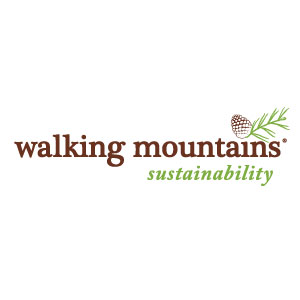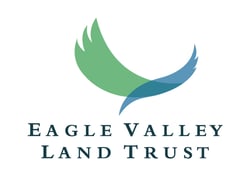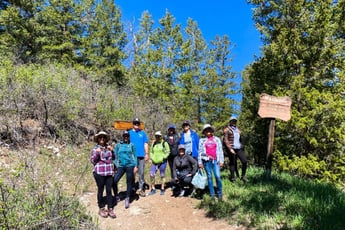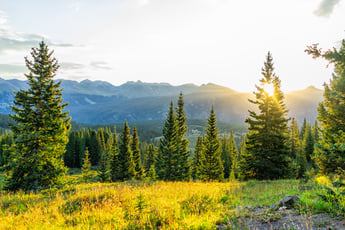Confíe En Nuestra Tierra (Trust Out Land): Financiando la Tierra de la que Dependemos
La conservación permanente de Brush Creek Valley Ranch y Open Space fue posible gracias a una larga...
Trust Our Land: ¿40 años de conservación y 14,000 más?
Bergen Tjossem
Eagle Valley Land Trust
El tiempo es medido diferente a los demás. Hace unos ciento treinta y ocho años las diferencias son visibles desde el comienzo de Eagle County, una comparación de alrededor de 14,000 años de historia humana es lo que hace a Colorado. Nosotros los recientes seres humanos hemos dejado nuestra marca, pero. Hoy en día, Eagle County tiene un aproximado de 55,000(y más) residentes, dos áreas de ski, el más visitado bosque nacional del estado (White River National Forest), tres áreas silvestres y una economía muy activa.
Nuestro valle se veía muy diferente incluso hace apenas 40 años. En ese momento, que coincidió con el establecimiento de Beaver Creek Resort, una coalición de líderes locales vio el potencial del Eagle River Valley y la comunidad que estaba destinado a fomentar. Reconocieron que nuestros ríos, vida silvestre y vastos espacios abiertos atraerán a personas y empresas de todo el mundo a medida que avanzaba la industria de la recreación local. También reconocieron que una industria que despega sin una cuidadosa planificación comunitaria podría socavar los cimientos que la llevaron al éxito en primer lugar. Para balancear las necesidades de nuestra comunidad local con las de una industria turística en auge, fundaron Eagle Valley Land Trust, una organización sin fines de lucro financiada por la comunidad dedicada a la conservación inteligente de espacios abiertos, hábitats de vida silvestre, ranchos y oportunidades recreativas para los lugareños y visitantes por igual.
En 1981, la conservación no era un concepto nuevo, pero aún estaba en su infancia. Se estaban desarrollando nuevas herramientas para ayudar a los conservacionistas y las comunidades a proteger los lugares que les importaban de una manera más equitativa y permanente. Una de estas herramientas, la servidumbre de conservación modesta pero firme, sigue siendo una herramienta principal empleada por los más de 1,360 fideicomisos de tierras en todo el país para proteger más de 56 millones de acres.
Una servidumbre de conservación es un acuerdo legal voluntario entre un propietario y una organización acreditada como EVLT que protege permanentemente espacios abiertos, hábitats naturales o áreas recreativas para beneficio público. Estos acuerdos se adaptan individualmente para proteger los valores de conservación de la propiedad al tiempo que permiten que la propiedad permanezca bajo propiedad privada. Están cuidadosamente diseñados para satisfacer las necesidades del propietario, al tiempo que garantizan un valor de conservación duradero para la comunidad. A diferencia de muchas otras herramientas de conservación, las servidumbres de conservación son permanentes y conviven con la propiedad incluso si se vende o se hereda.

Durante los últimos 12 meses, EVLT y sus socios, incluido Eagle County Open Space, han protegido más de 2,000 acres a través de servidumbres de conservación en el condado de Eagle, incluido Mulroy Ranch y una expansión de Brush Creek Valley Ranch & Open Space. Eso se suma a los más de 11,000 acres previamente protegidos por EVLT y sus socios. Las servidumbres de conservación también pueden funcionar en conjunto con las compras de conservación por parte de entidades públicas. Cuando una entidad pública compra un espacio abierto dedicado, la mayoría de las veces protegerá su inversión, y por lo tanto la del público, con una servidumbre de conservación. Es con asociaciones como estas y con propietarios privados que la conservación local avanza.
¿Estarán intactas las 38 servidumbres de conservación en el condado de Eagle en otros 14,000 años? Esa es una pregunta loca, y también lo que EVLT está planeando. El concepto de permanencia está entretejido en cada aspecto del ADN de la organización. Es por eso que el 40 aniversario de EVLT es un gran hito a perpetuidad, pero ciertamente no el último.
Trust Our Land: 40 years of conservation, and 14,000 more?
Bergen Tjossem
Eagle Valley Land Trust
Time is a disparate measurement. One-hundred-and-thirty-eight years since Eagle County’s beginnings are a drop in the bucket compared to the roughly 14,000 years of human history in what is now Colorado. We more recent humans do leave a mark, however. Nowadays, Eagle County has a thriving community of 55,000-plus residents, two ski areas, the most visited national forest in the country (White River National Forest), three wilderness areas and a humming economy.
Our valley looked much different even just 40 years ago. At that time, which coincided with the establishment of Beaver Creek Resort, a coalition of local leaders saw the potential of the Eagle River Valley and the community that it was bound to foster. They recognized that our rivers, wildlife and vast open spaces would draw people and businesses from around the world as the local recreation industry surged forward. They also recognized that an industry taking off without careful community planning could undermine the foundation that brought it success in the first place. To balance the needs of our local community with those of a booming tourism industry, they founded the Eagle Valley Land Trust, a community-funded nonprofit dedicated to the wise conservation of open space, wildlife habitat, ranches and recreational opportunities for locals and visitors alike.

In 1981, conservation wasn’t a new concept, but it was still in its infancy. New tools were being developed to help conservationists and communities protect the places they cared about in a more equitable and permanent way. One of these tools, the modest yet steadfast conservation easement, remains a primary tool employed by the over 1,360 land trusts nationwide to protect over 56 million acres.
A conservation easement is a voluntary legal agreement between a landowner and an accredited organization like EVLT that permanently protects open space, natural habitat or recreational areas for public benefit. These agreements are individually tailored to protect the conservation values of the property while allowing the property to stay under private ownership. They are carefully crafted to meet the needs of the landowner, while also ensuring lasting conservation value for the community. Unlike many other conservation tools, conservation easements are permanent, living with the property even if it is sold or inherited.
Over the past 12 months, EVLT and partners including Eagle County Open Space have protected over 2,000 acres via conservation easements in Eagle County, including Mulroy Ranch and an expansion of the Brush Creek Valley Ranch & Open Space. That’s in addition to the over 11,000 acres previously protected by EVLT and partners. Conservation easements can also work in tandem with conservation purchases by public entities. When a public entity purchases dedicated open space, they’ll more often than not protect their — and therefore the public’s — investment with a conservation easement. It’s with partnerships like these and with private landowners that local conservation moves forward.
Will all 38 conservation easements in Eagle County be intact in another 14,000 years? That’s a wild question, and also what EVLT is planning for. The concept of permanence is woven into every aspect of the organization’s DNA. It’s why EVLT’s 40th anniversary is a big milestone in perpetuity, but certainly not the last.
Bergen Tjossem is the Eagle Valley Land Trust’s deputy director. He can be reached at bergen@evlt.org. To learn more about EVLT’s local conservation work and how you can conserve your land, visit http://www.evlt.org.



La conservación permanente de Brush Creek Valley Ranch y Open Space fue posible gracias a una larga...

El tiempo es una medida dispersa. 138 años desde los inicios del condado de Eagle son una gota en...